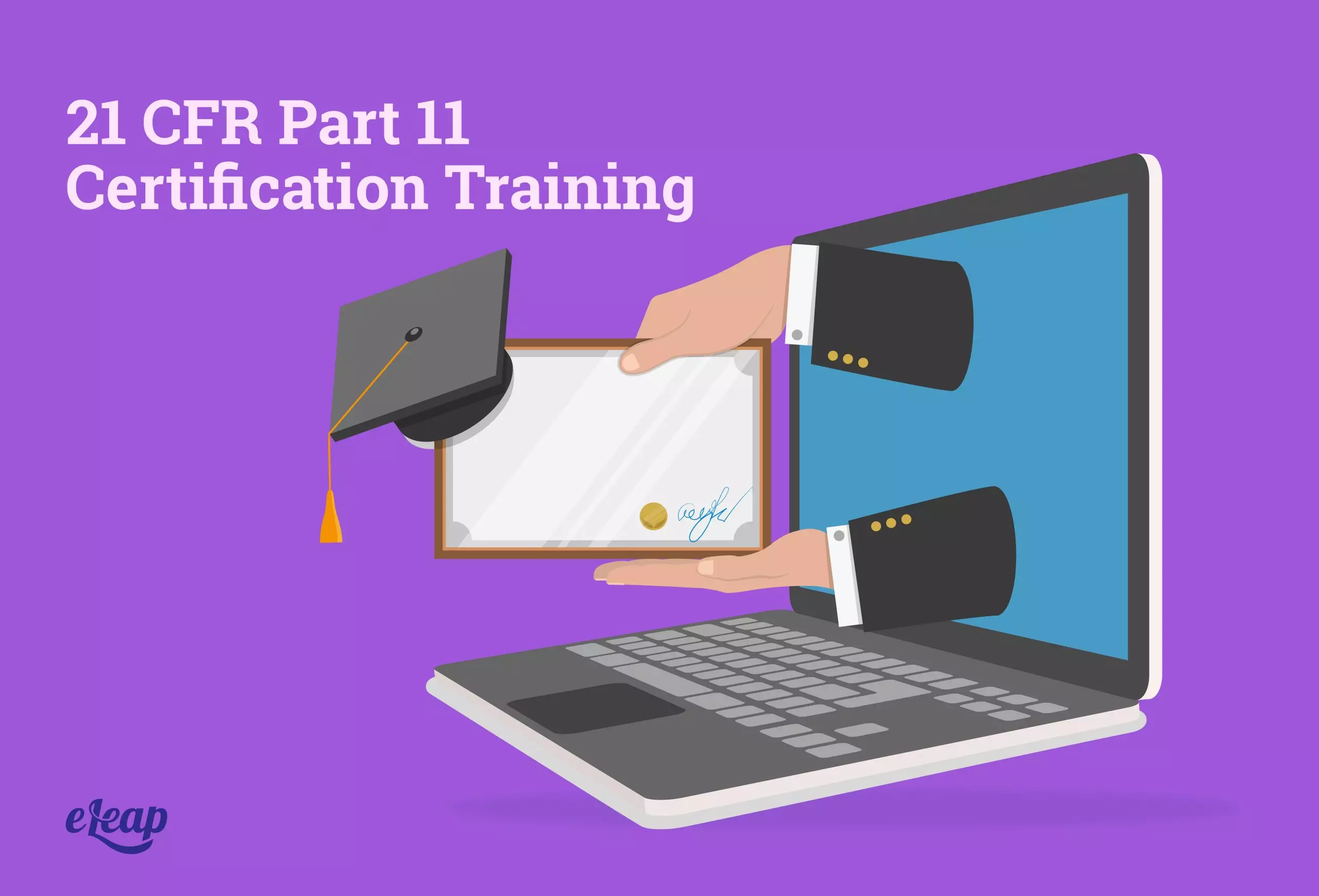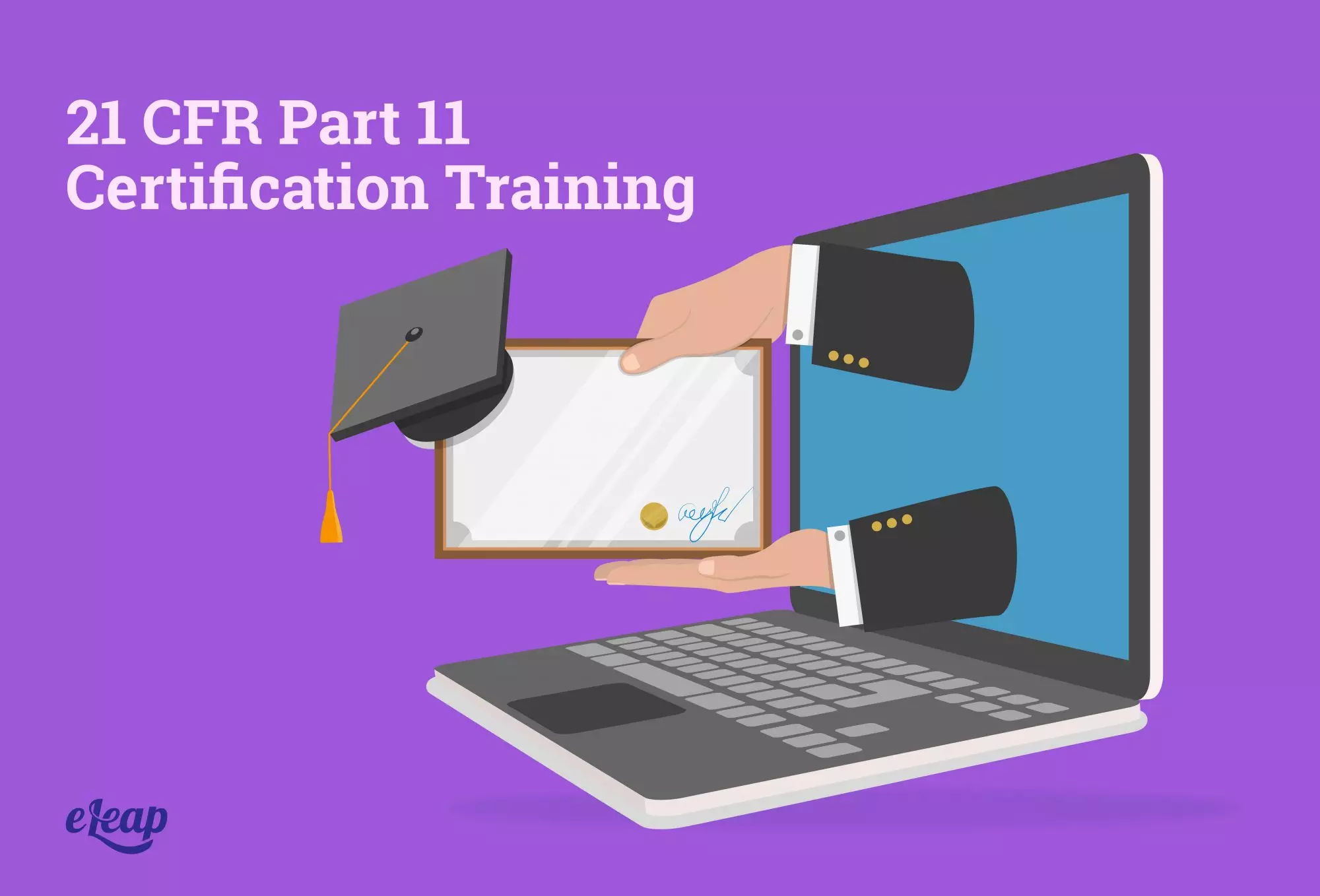21 CFR Part 11 Certification Training
Creating a 21 CFR Part 11 Certification Training Course Requires Specific Steps

Biotech companies, pharmaceutical firms, medical device manufacturers, and other life science companies must comply with the rules laid out in 21 CFR Part 11 by the FDA. One way to ensure that you’re able to do that moving forward is to create a training/certification course and make it part of your learning management system.
However, you need to ensure that your course delivers the quality training necessary, covers the areas required, and meets the onus of these federal regulations. In this guide, we’ll explore the components of a 21 CFR Part 11 certification training course to help ensure that you’re able to create a valuable business asset that will offer value for years to come.

Creating a 21 CFR Part 11 Certification Training Course
It’s important to remember that you will likely have employees from many different areas of the business taking the same course. Therefore, you need to ensure that it’s able to serve the needs of those many people. It may also be worth considering setting specific learner paths through the course modules specific to each learner’s responsibilities within the organization. With the right LMS (and one that’s compliant with the FDA’s requirements), it’s simple to set not just learning paths, but also to limit access to information, functions, and features within the system.
Take the course, “The GAMP Approach to 21 CFR Part 11 Compliance” to stay up to date and relevant.
Part 1 – An Overview of 21 CFR Part 11
The first module should be an introduction to 21 CFR Part 11 and what it is focused on. Namely, this section of the federal code of regulations deals with electronic records, electronic signatures, data access, and information security. As the value and availability of data have increased, it’s attractiveness to bad actors has as well. The dramatic rise in data breaches in recent years is evidence of this. The rules laid out in 21 CFR Part 11 evolved to deal with that situation.
Note that this part should also contain some background on 21 CFR Part 11. After all, it was initially rolled out in 1997, and final guidance was not issued until 2007. Background information will help learners to understand more about why the rules are as they are.
Part 2 – Current FDA Interpretation
The FDA has issued guidance documents for life science companies dealing with 21 CFR Part 11 that help to explain the rules and regulations, how they apply, and more. This module should walk users through the current FDA interpretation of Part 11.
Part 3 – Requirements Explained
With the background and the current FDA interpretation out of the way, it’s time to introduce your learners to the 21 CFR Part 11 requirements. These need to be laid out and explained as clearly as possible. Ideally, you will be able to provide the FDA requirement and then an explanation side by side. For instance, something similar to this format, which deals with learning management systems (electronic systems that store records/data all fall under the FDA’s mandate):
| 11.10 (b) | The system shall generate accurate and complete copies of records in human-readable and electronic form suitable for inspection, review, and copying | The LMS should provide you with reports detailing user progress, scores, weaknesses, and more. Those reports should be in PDF, Excel, HTML, or another accepted format, and should be ready for use within your company, or for sharing with FDA inspectors. |
Part 4 – Practical Examples
The next portion of your 21 CFR Part 11 certification training course should cover some practical examples of the rules and regulations. Because Part 11 deals with electronic records and electronic signatures, there are lots of potential practical examples that can be used, including the following:
- Examples highlighting the need for good password hygiene
- Examples highlighting unauthorized access attempts
- Examples highlighting the need for accountability and traceability
- Examples showing the use of usernames and passwords, plus other components
- Examples showing the need for and binding legal nature of electronic signatures
Part 5 – Creating a Compliance Plan
While users will need to comply with FDA mandates while executing their regular duties, those mandates must be embodied in a compliance plan created and executed within your business. This module should walk decision-makers and other stakeholders through the process of creating a compliance plan and should include a broad range of information, including:
- How you will validate software systems
- How you will enforce username/password rules
- How you will determine and then set user access restrictions
Part 6 – How Enforcement Works
The FDA doesn’t just set rules and then forget about them. Every year, they audit thousands of life science companies for compliance with 21 CFR Part 11. Of those, hundreds of companies are found to be out of compliance and are issued warnings. This module should highlight metrics and trends in the FDA’s enforcement of the organization’s regulations to help your teams understand the potential ramifications involved in a failure to comply. This section should include examples of warning letters, what to expect during an FDA inspection or audit, and more.
Part 7 – The Future
21 CFR Part 11 is not a static document. It’s a living thing, and it will change over time, although that change might be incremental. In this section, highlight potential changes that might be coming in the future based on emerging threats and trends today.
The Right LMS Is Essential to Your 21 CFR Part 11 Certification Training
As you can see, there’s a lot that goes into your 21 CFR Part 11 certification training plan. The right LMS is a critical consideration here. Of course, the learning management system must be compliant with the FDA’s requirements, but it also needs to offer the functionality and ease of use your learners deserve and the scalability that you need. We invite you to learn more about how eLeaP can fit your needs and ensure compliance with FDA rules.